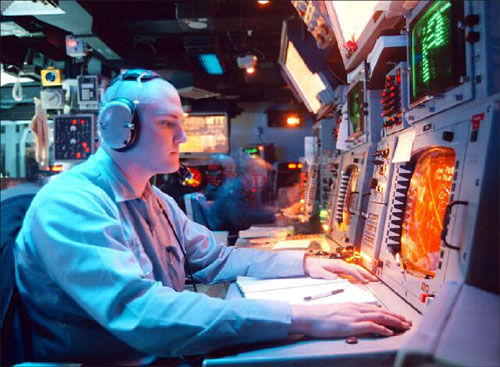Distributed Intelligence for Automated Survivability Thrust
|
Overview
With the introduction of
digital computer networks, naval machinery control systems
are undergoing tremendous change. However, most of the
new computerized machinery control systems are merely
a one-for-one replacement of their analog predecessors.
Little has been done to rethink the basic architecture
of machinery control, much less the broader scope of
ship-wide control. In order to achieve such advances,
this thrust is addressing the development of robust
control of automation architecture, the ability to provide
reconfiguration of systems in response to casualties,
and further improvements in automated damage control.
Research and development in distributed intelligence
for shipboard systems will produce payoffs for both
the surface and submarine fleets:
|

The
Distributed Intelligence for Automated Survivability
thrust develops automation architectures that push intelligence
to the lowest practical level in the system, thus providing
robust control and the ability to reconfigure in response
to damage events.
|
- Total ownership cost reduction will occur for complex
Navy systems; in particular, for surface ships. This will
be achieved through improvements in both acquisition, operational,
and maintenance costs. Operational and maintenance improvements
may be derived from more efficient operation of propulsion,
electrical and machinery systems; increased system reliability;
and optimization of manning requirements for machinery systems
and damage control.
- Improved warfighting capability will be achieved by reducing
vulnerability to damage and failure events, by assisting
in rapid recovery from failure or damage through dynamic
reconfiguration and rapid sensing and response, and by improving
the ability to fight while hurt.
Emphasis of the Thrust
Although the content of this effort is not divergent enough
to be specifically divided into sub-thrusts, there are three
major areas of emphasis:
- Distributed Intelligence Control Systems
- Characterization of Damage and Failure Mechanisms
- Unified Technology Evaluation Environment
Distributed Intelligence Control Systems
This initiative will develop systems theory for intelligent
distributed learning agents, for rapid casualty control and
reconfiguration, and for fusion of physical and information
processes. It will:
- Help optimize system topologies;
- Enhance control system dependability due to fault tolerance
and system integrity strategies;
- Realize life cycle cost savings associated with manning
reduction;
- Improve affordability through the use of Commercial Off
the Shelf (COTS) technology;
- Provide a modular, scaleable approach for ship automation
systems; and
- Improve the ability to sustain operational capability
after a weapon impact or internal ship casualty.
Characterization of Damage and Failure
Mechanisms
This effort will focus on modeling and simulation of ship
damage phenomenology in support of more intelligent sensors.
Work under this task will:
- Demonstrate real-time situational awareness during fire
casualty;
- Decrease time to detect, classify, and suppress fires
with reduced manning; and
- Further develop the ability to model a fire event.
Unified Technology Evaluation Environment
The intent of this segment of the thrust is to provide an
optimized technology assessment approach that can be used
to select system architectures and define the elements of
systems and their control. This will enable:
- Improved system survivability using segregated zones for
ship systems;
- An increase in unmanned spaces;
- Reduction of costs via manning reduction and use of commercially
off-the-shelf (COTS) technology; and
- Reduction of the sea-based infrastructure/hotel service
requirement by 5 tons/man.
Program Reviews and Workshops
Program Officer
Phone: 703-696-5992
E-mail: 334DI@onr.navy.mil |

